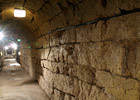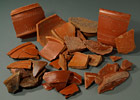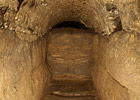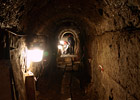Roman Sewer
One of the main sewers that ran under the street "Grose Budengasse" through the city wall to the Rhine is preserved underground; a part of it is elevated and set up at Theo-Burauen-Platz. A modern sewer crosses the historical construction at this spot.
The entrance to the sewer is located at the anteroom of the Praetorium. By passing through a modern tunnel, one reaches the Roman canal that lies 10 metres underground and is accessible to visitors for a length of 150 metres. Its internal width measures 1.2 metres and its height ranges from 2 to 2.5 metres. The canal is constructed from large tufa blocks, mixed with several smaller stones that had evidently seen a prior use. Here they have in some cases been put in place without mortar.
In this accessible section of the culvert, Roman entrance shafts for conducting cleaning and repair works, and the remains of later additions and access points, become visible. Whereas the culverts partly served as cellars in the Middle Ages, they were used as air-raid shelters in World War II.
During construction of the underground system, Cologne's transport services (KVB) came across the continuing part of the Roman sewer. With support of the Archaeological Zone, the KVB is now excavating the canal as far as Altermarkt, the Old Market. As the backfilling is entirely preserved and undisrupted, the archaeologists are expecting important information on the collapse of the Roman infrastructure. Botanic and other scientific examinations are accompanying the excavations.
After the year 2010, this new part of the culvert will be made accessible to the public.








